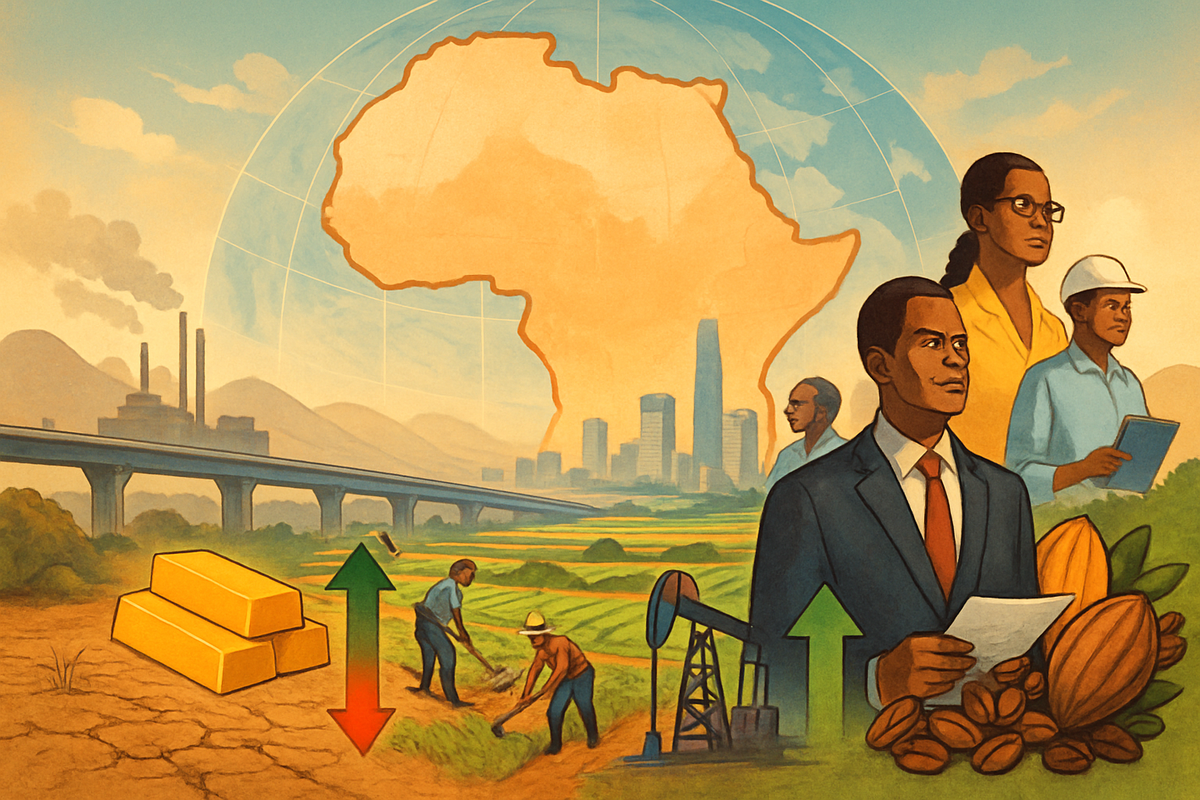Africa's Economic Resilience Tested by Global Headwinds and Volatile Commodity Markets

Africa's economic landscape, from late 2024 through mid-2025, has been a testament to both remarkable resilience and persistent vulnerability. Despite a projected growth trajectory, the continent continues to grapple with a formidable array of global headwinds, most notably the erratic fluctuations in commodity prices. These price swings, impacting everything from crude oil to cocoa, have created a patchwork of winners and losers, profoundly influencing national budgets, trade balances, and the daily lives of millions across diverse African economies.
The intricate dance between global demand, geopolitical tensions, and supply chain disruptions has kept commodity markets in a state of flux, directly challenging Africa's post-pandemic recovery. For many nations heavily reliant on raw material exports, this volatility has either provided unexpected windfalls or deepened fiscal strains, underscoring the urgent need for economic diversification and robust macroeconomic management in the face of an unpredictable global economy.
Commodity Swings and Economic Ripples Across the Continent
The period from late 2024 to mid-2025 saw a distinct divergence in commodity market performance, casting varied fortunes across Africa. Oil-exporting nations, such as Nigeria (NGX: NGXGROUP), Angola, Libya, and Algeria, faced increasing fiscal pressures as crude oil prices saw year-on-year declines in April 2025, primarily due to weaker global demand. This reduction in revenue necessitated tighter budget management and, in some cases, increased borrowing. Conversely, oil-importing economies like Tanzania, Kenya (NSE: KPLC), and Egypt (EGX: COMI) contended with higher energy costs, as global oil prices surged from approximately US$84.6 per barrel in the latter half of 2024 to US$89.3 per barrel in the first half of 2025. This rise fueled inflationary pressures, particularly impacting transportation and food costs.
In stark contrast, the precious metals sector offered a significant boost to some. Gold prices maintained a steady ascent from late 2024 into mid-2025, driven by strong investor demand for safe-haven assets amid global economic uncertainties. This trend proved highly beneficial for major gold producers including South Africa (JSE: ANG), Ghana (GSE: GGBL), Mali, and Tanzania, leading to increased export revenues and bolstered foreign exchange reserves. Similarly, copper prices experienced an uptick in April 2025 due to sustained industrial demand, providing a fillip to economies like Zambia, which saw its mining sector rebound strongly.
The agricultural sector also witnessed dramatic shifts. Cocoa emerged as the best-performing commodity in 2024, with prices soaring by an astonishing 185%. This unprecedented surge was primarily due to adverse weather conditions, including strong Harmattan winds and drier climates, in key West African producing nations like Côte d'Ivoire and Ghana, which collectively account for roughly 75% of global cocoa bean production. This provided a substantial economic boost to these countries. Coffee prices also rose in late 2024 and early 2025, benefiting Ethiopia, Côte d'Ivoire, and Cameroon. However, other agricultural commodities presented challenges; maize and rice prices increased in early 2025 due to unfavorable weather, impacting food security and inflation in countries like South Sudan and Rwanda, which saw maize price increases of over 200% and 30% respectively.
Corporate Fortunes in a Volatile Market
The fluctuating commodity markets have created a distinct bifurcation in corporate performance across Africa. Mining giants with significant gold operations, such as AngloGold Ashanti (JSE: ANG; NYSE: AU) and Gold Fields (JSE: GFI; NYSE: GFI), headquartered in South Africa, have likely seen substantial improvements in their revenues and profitability due to the sustained high gold prices. Similarly, copper producers like First Quantum Minerals (TSX: FM), with significant operations in Zambia, would have benefited from the rebound in copper prices, potentially leading to increased capital expenditure and job creation in those regions.
Conversely, oil and gas exploration and production companies operating in major African oil-exporting nations, such as Seplat Energy (NGX: SEPLAT; LSE: SEPL) in Nigeria or Sonangol in Angola (state-owned), would have faced headwinds from lower crude oil prices, potentially impacting their earnings and investment plans. Energy-intensive industries and transportation companies in oil-importing countries, like Kenya Airways (NSE: KQ) or various manufacturing firms in Egypt, would have seen their operational costs rise significantly due to higher fuel prices, squeezing profit margins and potentially leading to price increases for consumers.
In the agricultural sector, cocoa exporters and processors in Côte d'Ivoire and Ghana, including local cooperatives and international traders like Olam Group (SGX: O32) and Barry Callebaut (SIX: BARN), would have reaped substantial benefits from the record cocoa prices. This could translate into stronger financial results, increased farmer incomes, and greater investment in the cocoa value chain. However, food importers and distributors in countries heavily reliant on staple food imports, such as rice and maize, would have faced higher procurement costs, which they might struggle to pass on entirely to consumers already battling inflation, thus impacting their profitability and potentially leading to supply chain disruptions. Companies involved in agricultural inputs, particularly fertilizers, also faced cost pressures due to elevated global fertilizer prices, which could affect the affordability of farming for smallholder farmers.
Broader Implications and Strategic Imperatives
The ongoing commodity price volatility is not merely a cyclical event; it underscores deeper structural challenges and opportunities for African economies. This situation reinforces the urgency of economic diversification away from over-reliance on a few primary commodities. Initiatives like the African Continental Free Trade Area (AfCFTA) gain increased importance, aiming to boost intra-African trade and build more resilient regional value chains, thereby reducing vulnerability to external shocks. The varying impacts highlight the uneven development across the continent and the different fiscal spaces available to governments for responding to such crises.
Historically, Africa has experienced numerous boom-and-bust cycles tied to commodity prices. The current scenario serves as a stark reminder of the need for robust fiscal buffers, prudent debt management, and the establishment of sovereign wealth funds during periods of high prices to cushion against future downturns. Regulatory bodies are also under pressure to implement policies that stabilize food prices, protect vulnerable populations from inflation, and encourage investment in non-commodity sectors. The global push for green energy, for example, presents both a threat to fossil fuel exporters and an opportunity for nations rich in critical minerals like cobalt and lithium, prompting strategic shifts in resource management and industrial policy.
Navigating the Path Ahead
Looking forward, Africa's economic trajectory will largely depend on its ability to manage these persistent global headwinds and strategically leverage its resources. In the short term, countries will continue to grapple with high inflation and elevated debt servicing costs, consuming a significant portion of government revenues (estimated at 27.5% across Africa in 2024). This will necessitate difficult fiscal choices and continued engagement with international financial institutions for support. The ongoing tight global financing conditions and capital outflows will likely persist, limiting access to external funding and exacerbating fiscal constraints.
In the long term, the continent's resilience will hinge on accelerated structural reforms, including improving governance, enhancing the business environment, and investing in human capital and infrastructure. The continued implementation of the AfCFTA could unlock significant opportunities by creating a larger, more integrated market, attracting foreign direct investment, and fostering industrialization. Market opportunities may emerge in sectors that support diversification, such as renewable energy, digital services, and value-added agriculture. However, nations heavily dependent on single commodities must explore strategic pivots towards processing raw materials locally to capture more value and create jobs. Potential scenarios range from a continued multi-speed recovery, where diversified economies outperform, to a more challenging environment if global demand further weakens or geopolitical tensions escalate.
A Continent at a Crossroads
In summary, Africa's economic journey from late 2024 to mid-2025 has been defined by a complex interplay of global headwinds and commodity market dynamics. While the continent as a whole shows encouraging signs of growth and resilience, this masks significant regional and national disparities. The volatility in commodity prices has underscored both the potential for rapid gains (e.g., gold, cocoa) and the profound vulnerabilities of economies reliant on single exports (e.g., oil).
Moving forward, the imperative for African nations is clear: foster economic diversification, strengthen fiscal positions, and enhance regional integration. Investors should closely monitor commodity price trends, particularly for key exports and imports, as well as the progress of structural reforms and regional trade initiatives. The ability of African governments to manage debt, control inflation, and attract sustainable investment will be crucial in determining the continent's long-term economic stability and prosperity in the face of an ever-evolving global financial landscape.
This content is intended for informational purposes only and is not financial advice
More News
View More




Recent Quotes
View More
Quotes delayed at least 20 minutes.
By accessing this page, you agree to the Privacy Policy and Terms Of Service.